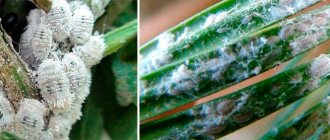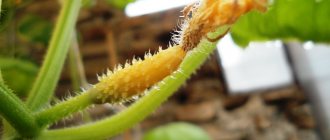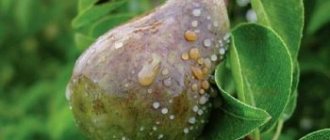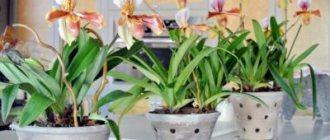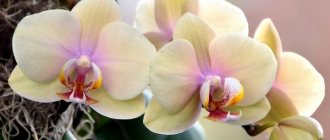Common Causes
Messages can be of different kinds, relate to different types of orchids, but in general the meaning is clear. The plant has ceased to show interest in active growth and development in general. There may be many reasons why an orchid does not grow, but we will look at the most common ones. So, in order, what can cause such a prolonged stagnation in development:
- The plant experienced stress from a sudden change in environment.
- The orchid does not have a favorable temperature regime.
- Watering is too intense or, conversely, insufficient. Maybe it is not produced according to the rules at all.
- Too active lighting (or too low intensity).
- Incorrect or untimely application of fertilizing.
- Poor care.
Now about all the reasons and their correction in more detail.
Abrupt change of scenery
This implies a combination of several factors at once. For example, in a nursery or store, a plant developed for a long time at such and such a temperature, at such and such humidity, with the implementation of bait according to such and such a schedule. But when it moved to a “new place of residence,” all these care factors were disrupted to one degree or another.
Any orchid, and even the most resistant phalaenopsis to external factors, can fall into a kind of stress, reminiscent of some kind of prolonged hibernation.
The plant appears to be in perfect order. The foliage is green, rich, no signs of disease or yellowing, but the orchid does not grow leaves, although 1-2 new ones must grow between flowering periods. In this case, the owner is advised to visit the store and learn more about the methods of keeping the plant in the store (or nursery) and adjust the care criteria in accordance with them. If for some reason this is not possible (the plant was brought as a gift from another city, etc.), you should pay attention to the following reasons.
Why does an orchid need it?
Thanks to it, during the active growing season, leaves, aerial roots and peduncles appear - all these parts communicate with each other and form a single system. That is, growth points develop the plant and create the prerequisites for the full functioning of the orchid:
- nutrition - with the help of leaves and aerial shoots.
- reproduction - with the help of children developing from buds on flowering shoots.
Therefore, for monopodial plants (for example, for the Phalaenopsis orchid), the absence of a rosette tip threatens death. The growth of the flower stops, it becomes unable to obtain nutrients.
For a sympodial orchid, its absence is not so dangerous. One shoot stops growing, but the rest continue to develop. This should not be ignored. If the area where new shoots ripen is affected by rot, the disease can spread to healthy tissue of the flower and to other plants. This is also evidence of inappropriate living conditions or illiterate care.
Air temperature
Maintaining temperature conditions is very important. Any orchid at home should be kept at a temperature not lower than 18 and not higher than 25 ° C. This means that day-night differences should not be more than 7°, although it is better that the amplitude is no more than 4–5°.
Important! Beware of drafts! Any orchids, including the most persistent phalaenopsis, react very poorly to them. Constantly keeping a pot with a plant on a windowsill that is poorly sealed from drafts can plunge the plant into stressful hibernation!
Caring for her and the plant itself
After a successful amputation, the indoor exotic will have a pair of lower leaves and a stump. This rosette will not be able to grow further, but the plant is not lost yet. An orchid can recover in two ways :
- from dormant buds on a peduncle;
- from dormant basal buds.
We talked in detail about how to awaken the sleeping buds of an orchid in this article.
Under favorable conditions, new shoots will certainly appear. But their growth can also be stimulated artificially. On the peduncle, the buds are visually visible, although they are covered with scales. With stem plants the situation is more complicated. The bud is located under the leaves, in the axils or deep in the roots. You should look for them in places where there were leaves, but withered away due to age. Green, living basal buds can also be used to produce babies. You should carefully apply hormonal cytokinin paste to them and wait for the result.
Advice! If necessary, repeat the application of cytokinin paste 2-3 times.
During the first time after amputation, be sure to adhere to the following recommendations.
- Remove it from the south window sill or shade the light with a tulle curtain. In autumn and winter, provide artificial lighting. The duration of daylight hours should be 10-12 hours. It is better to choose a place with diffused lighting.
Maintaining temperature +16-18ºС. Do not place under air conditioning or leave in a draft; the plant may become overcooled. In winter, do not place near heating radiators.
- Humidity within 50-60%.
- Ventilate the room regularly.
- Moisten the flower once every 7-10 days; in between, the soil should dry completely.
- Carefully ensure that moisture does not remain on the leaves. After watering, remove stagnant water from the leaf axils within 30 minutes.
- After a couple of months, you can start using complex mineral fertilizers.
Even when the growth point is completely dead, the plant can be revived by following all the specified rules. And the key to active growth and bright flowering is favorable conditions during gestation and plant hygiene. Also, do not forget to regularly inspect your indoor exotic plants. After all, if infectious diseases are recognized in the early stages, severe consequences will not occur.
One of the characteristics of orchids is their aerial roots. Sometimes the roots begin to grow upward. Why this happens and what to do, as well as what a bulb and pseudobulb are - read on our portal.
Watering
Excessive watering not only slows down the growth of plants. In this case, their roots begin to rot and the plant will not only develop poorly, but may also die. But rotting of the roots is immediately visible. And if we are talking about reasons that are difficult to determine, then, most likely, underwatering will be to blame. Fresh roots of a well-watered orchid have a lush green color (with some inclusions). If a lot of dry, dead rhizomes form among the roots, and fresh roots are pale and inconspicuous, this may indicate a lack of moisture.
Important! To water orchids, it is imperative to use warm (at least 15 °C) water that has been standing for 2-3 days! It is very possible that the plant refuses to develop due to excess bleach or because the water is too cold!
Treating orchids for rot
Plants affected by fungal diseases and rot are the most dangerous. Fungal spores quickly spread through tissues and can also infect other plants. To get rid of the disease, you need:
- Using a sharp knife, remove all rotten parts of the orchid to the healthy green pulp.
- Treat sections and exposed tissue with a disinfectant. It can be replaced by cinnamon powder, activated carbon, a solution of brilliant green or iodine.
- Allow all treated areas to dry.
- Treat the soil and the plant itself with a fungicide.
For this purpose, Fitosporin-M is used at the rate of 100 ml per 1 liter of water. In case of severe damage, take 200 ml of water per 100 ml of product. The drug is diluted in purified water at room temperature.
Another fungicide effective against rot is a low concentration solution of copper sulfate. For 500 ml of water, take several crystals - on the tip of a knife. Antiseptic is used for adult orchids. Treatment of young flowers is carried out with Bordeaux mixture, which is diluted at the rate of 4 ml of product per 10 liters of water.
Repeat the disinfection procedure two or three times within 2 weeks.
If the decay can be stopped, optimal growing conditions are created for the orchid.
Lighting
The plant should not stand in direct sun. And if you have no choice but to place the orchid on a south-facing window, take care to create partial shading for it, causing direct sunlight to dissipate. Do not forget that in the wild, all orchids grow exclusively under the canopy of the spreading crowns of tropical trees. Due to constant overheating, they will always be in a state of stress, and here they will definitely not have time to grow. Here they will be more concerned about the issue of survival.
Options for making it bloom
If a tropical paradise has been made from the apartment, and the flowers continue to develop, re-sprouting new leaves and roots, but not arrows, it’s time to think about more radical techniques on how to force the orchid to bloom at home. You can often hear that there is no need to indulge a capricious flower. It is much more effective to cause him stress, after which the orchid will bloom all year round.
Changing the conditions of detention
Why do orchid leaves wither: reasons and methods of dealing with them
Creating the right lighting for orchid species is of great importance if they are planned to bloom. Both too dark and too light places for placing a pot are equally harmful. Exposure to direct sunlight is unacceptable, as it immediately dries out the root system, instantly depletes the plant, and then leads to its death.
If the orchid is too weak, it must be urgently moved to another place. If there is no acceptable level of light, artificial gentle lighting should be organized using conventional daylight or LED lamps. There is no need to place lamps close to the flower, as you can burn the foliage.
How to force a houseplant to enter the flowering phase?
Note! It is better to organize diffused light. When the orchid gains strength and recovers from the stress caused by improper lighting, it begins to bloom.
Stop watering
Simulating the rainy season helps encourage the flower to bloom wildly. Below is a step-by-step action plan on how to do this. To do this, the pot with roots is immersed in warm water for three days in a row (water temperature should be 35 °C) and left for 2 weeks without watering. The flower perceives this change in the irrigation system as the end of the rainy season and begins to produce either new shoots or buds immediately.
Before using chemical compounds to stimulate flowering, it is worth trying the watering trick, because it is the safest and most natural for orchids.
Watering an orchid
If you water the plant strictly, after the substrate has completely dried, as evidenced by the lightening of the roots almost to white, the orchid will soon release an arrow and bloom. If necessary, during watering you can also feed with a small dose of potassium phosphate fertilizer, which also stimulates flowering.
Treatment with drugs
Before an orchid blooms, you need to carefully examine it. And not only the above-ground leaf part, but also the root system. If all parts of the plant are completely healthy and well developed, you can begin to stimulate flowering. If there is any doubt that the plant is not in very good condition, do not take risks.
A solution of succinic acid (2 g per 2 liters of water), which is used to fertilize an orchid, can cause violent flowering. After just 2-3 treatments with this substance, the plant releases the inflorescence. You can also wipe the leaves with the nutrient solution.
Fertilizing a flower
Treatment with Epin also gives good results. You can feed the plant using a solution (3 drops per glass of water); the orchid is sprayed daily with a spray bottle until a new arrow comes out. Also, once a week, flower growers advise watering the plant with this solution.
What to do to make an orchid bloom? For active flowering, the flower is fertilized with potassium-phosphorus fertilizers, which give impetus to the formation of flower shoots and buds. It is not worth using them during the growing season or restoring the orchid after damage to the root, because you can quickly ruin the phalaenopsis.
After flowering, the shoots of the inflorescence should be pruned. Typically, the incision is made above the third kidney. This is necessary for abundant orchid flowering in most species. However, it happens that such pruning can damage the structure of the entire plant: it will stop its growth and, accordingly, prevent flowering.
For your information! An orchid that reacts poorly to improper pruning of shoots is phalaenopsis. In this case, it is better to wait until the inflorescence shoot begins to dry out completely.
When determining why an orchid does not bloom, it is worth paying attention to how often the plant is fed. Orchids can bloom both in the absence of fertilizer and in excess of it. In the first case, the plant does not have enough nutrients for flowering; in the second case, development may go towards excessive growth of leaves and roots.
Inspection of the flower
So how to fertilize correctly and how to make orchids bloom? First of all, you need to use specialized fertilizers, which are sold in a wide range in flower shops. Most often they sell concentrates, which must be diluted with water and used according to the instructions. Plants are given small doses - once every 2-3 weeks during the entire growth period. No feeding is carried out during the resting phase. Feeding may be more intense when the orchid begins to produce flower buds.
When thinking about why phalaenopsis does not bloom, it is important to examine the substrate. Orchids should be grown from a soil mixture that should consist of peat, leaf soil, fern roots and moss. All voids must be filled with bark and reliable drainage ensured.
Note! Orchids are rarely replanted - only when the roots fill the holes in the container. An indoor flower that has changed too many pots may not bloom in the coming months.
An orchid may not bloom due to a weakened immune system. Common causes are diseases or pests. In addition, dry indoor air is harmful to them. During the growth period, this affects the weaker growth and health of specimens, and during flowering it leads to drying out of the buds.
Nutrition
An important factor in encouraging a plant to grow and develop is feeding. Nowadays, a huge number of different complexes have been developed, some of which stimulate plants to flower, some are created to extend the duration of flowering, but there are also growth stimulants among them. All of them, for the most part, are similar in composition and are well suited for both the most common phalaenopsis orchids and other varieties.
Feeding is very simple. It is enough to prepare a nutrient solution of the required concentration (specified in the instructions) and, immersing a pot with a flower in it, let it stand in it for a certain amount of time (this should also be indicated in the instructions).
Important! Do not under any circumstances exceed the permissible concentration limits specified in the instructions! This can lead to disease and death of the plant!
Achieving growth
An excellent way to bring a plant out of a long hibernation, according to many flower growers, is a “shock” change of environment.
“Shock” technique using the method of sharp temperature increase
For one and a half to two months, place the plant in a room with a temperature of 14–15 °C. In this case, the hibernation of any orchid (including the phalaenopsis orchid) will be justified, because during periods of short tropical “winter” this is the average temperature that is maintained in their native lands. After the plant has been in a relatively “cold” environment for a long time and is brought into a warm room (20–25 °C), it, finally realizing that spring has come around, will begin to develop rapidly.
“Shock” technique using the method of sudden changes in lighting
The technique is similar to the previous one, only here, where the temperature is low, low lighting is used. Place the plant in deep shade for a month to a month and a half. You can place it in another room, located on the north side of the building, and place it not directly on the window sill, but in the corner of the room. When, after the specified period, you suddenly take it into a well-lit room by the sun and place it on the windowsill, it will also feel a strong urge to develop.
Health to you and your orchids!




